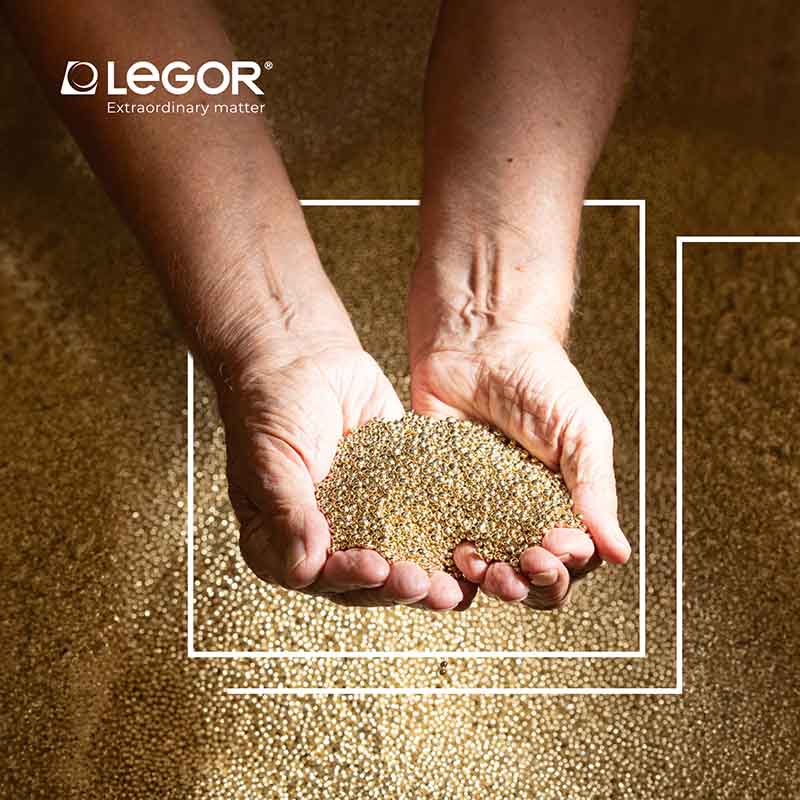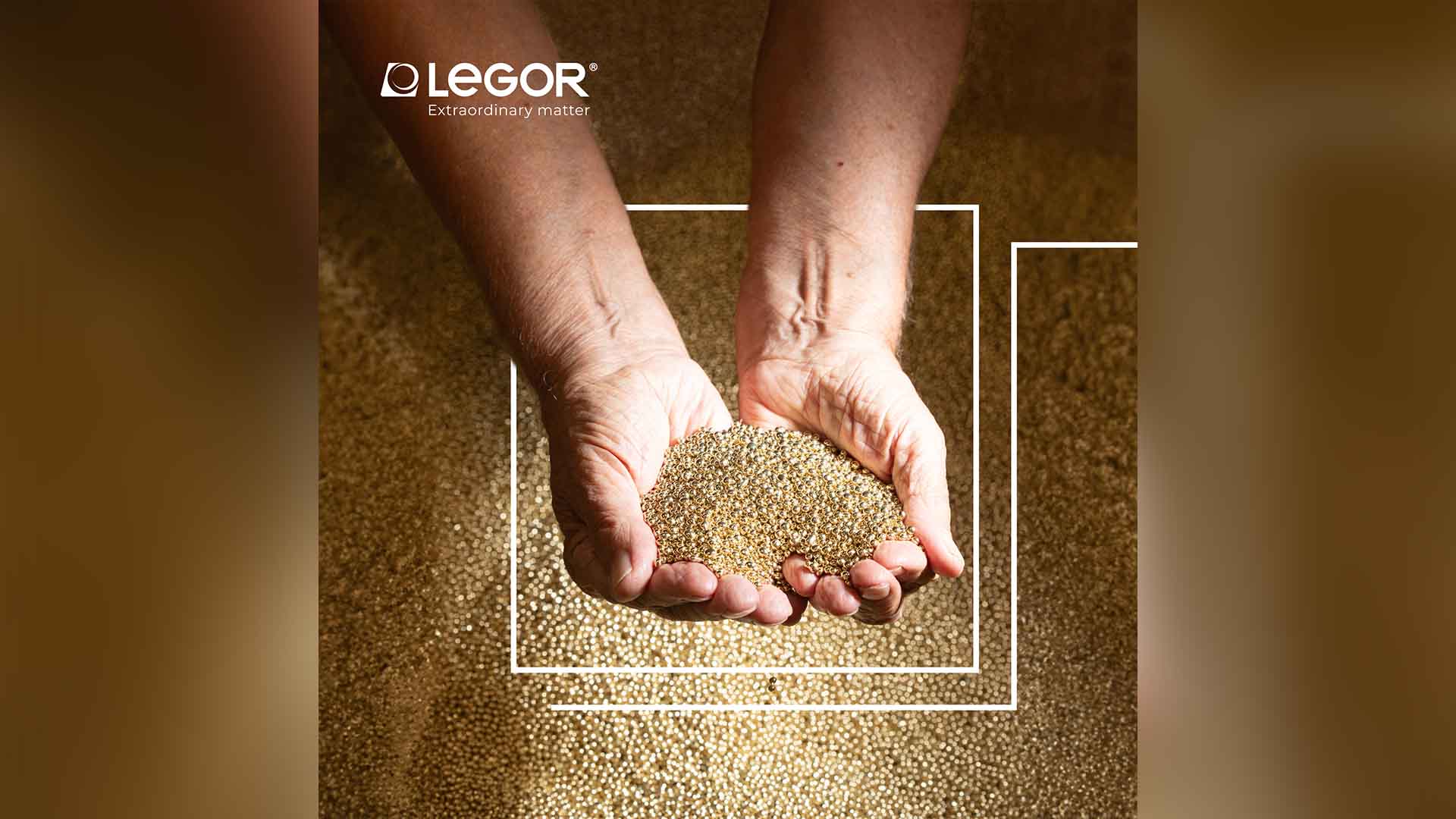For over 40 years, Legor Group has been transforming metals into alloys, powders, and galvanic solutions of excellence to bring fascinating creations to life. As a pioneer in new technologies, the company continues to explore and enhance the peculiar and stellar qualities of metals, helping customers turn their ideas into remarkable realities.
Driven by a commitment to sustainable innovation and knowledge sharing, Legor fosters long-term growth through inventiveness, teamwork, expertise, individual responsibility, and customer care. This approach has built lasting relationships founded on trust, collaboration, and a shared vision for continuous advancement.
What are the most common challenges your clients face before turning to your solutions?
Our customers – operating in the jewellery, fashion accessories, or industrial galvanic sectors – often face challenges such as low casting yield, poor mechanical performance, colour inconsistency, or difficulties in meeting international standards (such as nickel release limits in white gold alloys).
These issues stem from the metal transitioning from a liquid to a solid state inside a mold, which naturally involves volume changes during solidification.
On top of this, they also struggle with inefficient process control, difficulties in recycling metal scraps, and compliance with environmental regulations.
All these factors lead them to seek advanced metallurgical solutions like ours.
A high-quality alloy enables a successful production process with minimal waste, which in turn allows the final galvanic coating to perform better in terms of durability, brightness, and uniformity.
How do you typically discover and define a client’s productivity problem before offering a solution?
We always start with an in-depth technical consultation that includes a thorough analysis of the production setup, the metals in use, casting or mechanical processing methods, and scrap or rework rates.
Our technical team, through the Legor Lab, analyses cast samples, defect morphology, scrap percentages, and, when needed, furnace residues.
This investigative approach allows us to identify the root cause of the issue and recommend targeted alloy formulations or improvements to the galvanic process.

In what ways do your products directly address these challenges and remove barriers to efficiency?
Our Master Alloys are engineered to optimize every stage of the production process — from casting to finishing.
Concrete examples include:
- High-fluidity alloys to improve mold filling and reduce porosity
- Age-hardening formulations to achieve higher mechanical strength in the final product
- Nickel-free white gold alloys and lead-free brasses to comply with international regulations
- Ready-to-use silver alloys to ensure excellent surface quality, repeatability, and reduced oxidation
In our plating division, we reduce process inefficiencies through cyanide-free gold baths, high-deposition-efficiency formulations, and colour consistency aligned with international NIHS standards.
What role does innovation (in design, materials, digitalization, automation, etc.) play in transforming client problems into measurable results?
Innovation is our cornerstone. We invest heavily in R&D, especially in:
- Additive Manufacturing using Binder Jetting technology, where we are pioneers in the use of 925 silver and 950 platinum for jewellery applications (and beyond), opening up new possibilities for complex geometries without the need for molds thanks to 3D printing
- Tailor-made projects developed in our Research & Development Laboratory, in addition to the rigorous quality control performed on our products
How do you ensure a smooth transition from problem recognition to implementing your solution at the client’s site?
We follow a structured process divided into five key phases:
- Technical diagnosis
- Laboratory analysis of the sample
- Proposal of a new working procedure and/or development of a new product, if deemed necessary
- Industrial testing on pilot batches (only in case of new product development)
- On-site implementation and support (only in case of new product development)
Our specialized technicians visit customer facilities, provide training, and monitor results to fine-tune process parameters, ensuring full adoption of the new alloy or plating solution.
Do you adapt your products to specific industries or customer needs, and if so, how?
Absolutely.
When standard solutions are not enough, we develop custom formulations thanks to:
- Metallurgical and chemical expertise
- Flexible production, including small batches
- Deep understanding of manufacturing processes
This enables us to respond quickly to niche markets and emerging trends, such as hypoallergenic products or those with low environmental impact.
What key metrics do your clients use to measure productivity improvements after adopting your solutions?
Typical metrics include:
- Casting yield improvement (% decrease in rework or scrap)
- Long-shelf life plating solutions: Our plating solutions are designed for long-term use. They do not require frequent bath replacement and ensure high reproducibility of deposits, batch after batch.
- Cycle time reduction
- Hardness or mechanical property enhancements
- Improved mechanical properties
- Improved tarnish resistance
- Enhanced visual quality (porosity-free surfaces, smoother and brighter finishes)
- Higher pass rate in regulatory testing (e.g., nickel release compliance)
Can you share a concrete example where your product significantly boosted a client’s productivity?
One notable case involved a customer producing 18kt red gold jewellery experiencing frequent cracking. After analysing the issue, we suggested a high-strength thermo-hardening alloy and optimized their quenching protocol (quenching immediately in hot water at 50°C).
The result: a 90% drop in cracking defects, increased casting yield, and a 30% reduction in finishing time, thanks to improved microstructure and surface quality.

How do your solutions not only solve immediate challenges but also support long-term operational efficiency and sustainability?
We focus on:
- The use of precious metals exclusively from recycled sources, supported by certificates of analysis, for the production of our alloys and plating solutions — with strict supply chain control
- The use of 100% recycled non-precious metals for products certified UNI EN ISO 14021
- Highly reusable alloys → reduced waste generation and cost-saving
- Toxic element–free formulations → full compliance with REACH and RoHS regulations
- Long-lasting galvanic coatings → extended durability of the final product
- Long-shelf life plating solutions → Our plating solutions are designed for long-term use. They do not require frequent bath replacement and ensure high reproducibility of deposits, batch after batch.
Our long-term goal is to ensure process stability, enabling our customers to increase productivity while maintaining both quality and regulatory compliance.
What future client challenges do you anticipate, and how are your products evolving to address them?
We foresee:
- A growing demand for sustainable and recyclable materials
- Stricter international regulations (e.g., REACH extension)
- A need to shorten product development timelines
- The integration of digital manufacturing (e.g., 3D printing) with traditional methods
To address these trends, we are:
- Expanding our 3D printing service using Binder Jetting technology
- Improving products and solutions by progressively eliminating toxic substances that could pose a risk to the health of operators and end users, without compromising performance


